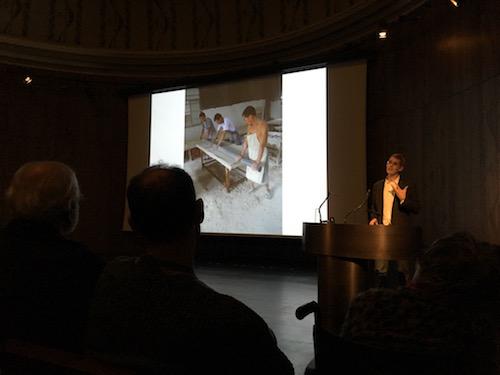This was briliant. Normally I get quite bored in lectures but this talk was fascinating, and when you remember that it was esentially all about porcelain that makes it all the more incredible.
It's tricky to know whether to write a review about Edmund de Waal himself, or the content of the lecture, as both were equally fascinating. Simply dressed in jeans, a white shirt and dark blue jacket de Waal appreared to have no arrogance but just a thin, academic intensity. As he spoke he often seemed to become so moved that he was on the verge of tears, his passion for the subject infecting you and dragging you along. For somone who is one of the most famous contemporary artists, with work selling at high prices, this was interesting. In person he seemed less like a world famous artist and more like a monk, intense with devotion.

This also fits with the leture which essentially detailed his journey, or pilgrimage, to understand and visit the places in the world key to the history of porcelain. This journey is detailed in his new book The White Road. De Waal explained his compulson for porcelain, this strange beautiful translucent material, favoured for gifts by royalty. But he also pointed out it's dark side, and how this beauty seemed to be constantly at odds with sinister undercurrents.
For instance he visited a hill of white clay in China, where he burst into tears to find a broken porcelain pot - only for his guide to start laughing, as around the corner were hundeds of these broken pots from the past. This hinted at the duality of porcelian, as despite it's beauty it's incredibly hard to work with. But this was not as dramatic as his images of porcelian workers today with their feet deep in porelain dust. A dust that when breathed in takes decades off your life.


Section of broken porcelain pot from China.
But the darkest section was where de Waal discovered how the SS had adored porcelain objects and had had them made in the Dachau concentration camp. The images he showed of a porceain Bambi with the rune of the SS on the bottom and Hitler smiling with pleasure at the porcelain gifts he was given for his birthday were chilling.
To try and cope with these discoveries de Waal explained how he made three poetic pieces of work. One with white porcelain, one with black porcelain and a final huge piece with a vitrine the size of the lecture screen, and the pots carefully and poetically arranged inside.
Throughout de Waal's passion was extraordinary and inspirational. Not only does he not seem to sleep, "I drink too much coffee, and when I'm writing and researching it just seems such a waste to sleep," but he is totally obsessed with porcelain. At one point he let slip how he'd bought a huge amount of broken porcelain objects, just so he could put them back together, as if he just could not bear the idea of them being broken. It was more a lecture about passion than porcelain.
Review by Robert Dunt, ArtTop10.com Founder, www.robertdunt.com